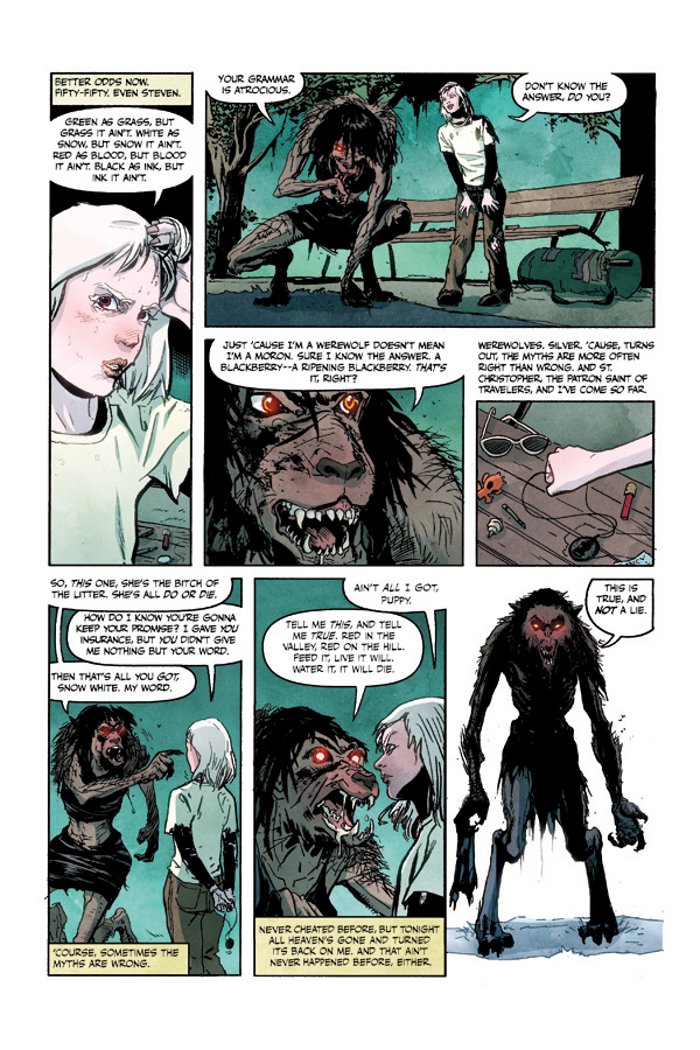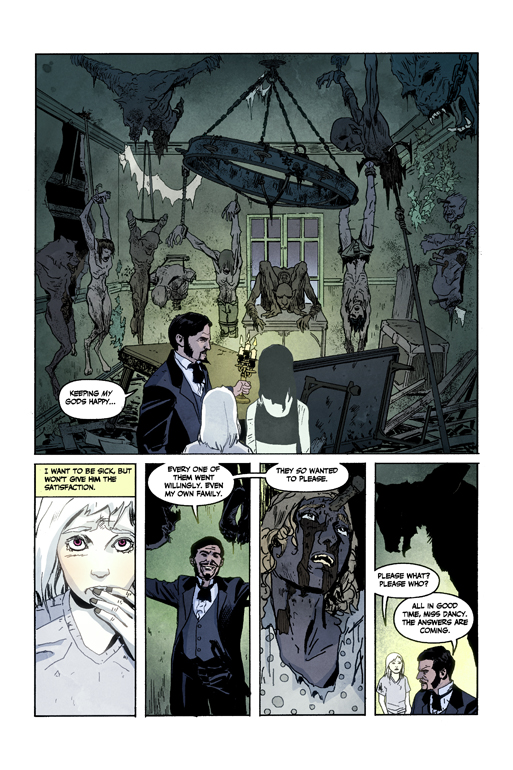The Indispensable CALVIN AND HOBBES by Bill Watterson
WHO'S WHO?
 |
| Hobbes |
 | |
| Calvin |
 | |
| Calvin's parents |
 |
| Susie Derkins |
 |
| Rosalyn |
There are other characters that appear occasionally in the strips like Moe, the bully who picks on Calvin. There is also Miss Wormwood, Calvin's teacher, and Mr. Spittle, the principal, whom he is often threatened to go see by Miss Wormwood.
THIS IS WHAT HOBBES REALLY LOOKS LIKE...
 |
| Example of a color strip |
Hobbes appears to be a real tiger in the first panel when Calvin is the only one around but as soon as Susie appears, Hobbes turns into an inanimate character that can't even stand up straight.
WHAT IS IT ALL ABOUT?
This graphic novel is a compilation of daily strips that range in length. Watterson refers to it as a "Calvin and Hobbes Treasury". While some strips are only four panels long, others are two pages long. Some strips are also printed in color while the majority remain in black and white. The main storyline is about a precocious and adventurous six-year-old boy named Calvin and his stuffed tiger named Hobbes. Calvin constantly pushes everyone's buttons and knows no boundary. He is always doing something that he should not be doing, making Hobbes his partner in crime. Although Hobbes is always caught in the act with Calvin, he is much more rational and aware of the consequences, he just never interferes with Calvin's mayhem. But behind the humor of the strips, Bill Watterson reveals modern, everyday morals and the reoccurring theme of mischief.
SEE WHAT I MEAN? ALWAYS PUSHING BUTTONS!
Calvin's father wanted to take a picture for their Christmas card but just before the count of three, Calvin made an ugly face - a typical Calvin move. It went on like this for twenty minutes until the camera ran out of film.
 |
| Example of 2-page long strip |
 |
| Strip continued from left |
Calvin decided is was a good idea to take Rosalyn's notes and "flush them down the toilet". He didn't end up doing it, he just wanted to stay up until his parents came home for once. But, he fell for Rosalyn's trick of calling the fire department and he opened the bathroom door. Rosalyn caught him and sent him to bed. Calvin and Hobbes only ended up staying up a half hour than usual... and his parents had to pay her more for her troubles since she didn't get to study.
Calvin sprayed his mom with the hose as she walked out the door after getting ready to go out. He had no idea why she got so mad either.
Calvin wants to go outside and play but he didn't clean his room so his mom "fixed her mind-scrambling eyeball ray" on him and "suddenly filled [him] with the desire to go back upstairs and do her nefarious bidding".
Bill Watterson also includes puns as part of the humor:

An inventive addition to the comic strips, a characteristic of Watterson's work, is Calvin's multiple personalities that show his imagination. There are several strips that are printed in color, representing Calvin as a superhero. His three other roles are:
The one thing that I do not understand about Watterson's work is the inconsistency of every panel containing an outline. At least one panel in every comic strip is missing the outline.
Because Bill Watterson dismisses the existence of an outline, I would present him with a 9 out of 10 on his creation of Calvin and Hobbes.
WHO IS BILL WATTERSON AND WHAT IS HE DOING NOW?
 Bill Watterson created Calvin and Hobbes in 1985 with inspiration from Peanuts, Pogo, and Krazy Kat. His style also resembled Windsor McCay's Little Nemo in Slumberland. Watterson was the original creator using aspects of his own life in the comic strips including speeches from his own father about character building and his cat Sprite who was the inspiration for Hobbes.
Bill Watterson created Calvin and Hobbes in 1985 with inspiration from Peanuts, Pogo, and Krazy Kat. His style also resembled Windsor McCay's Little Nemo in Slumberland. Watterson was the original creator using aspects of his own life in the comic strips including speeches from his own father about character building and his cat Sprite who was the inspiration for Hobbes.
EVERY DAY MORALS YOU ASK?
Bill Watterson expresses the maturity of Calvin's brain and includes sophisticated thoughts and morals of every day life:
What if you really do become famous? The public is going to know all about your boring life. Why not have fun and make a difference all the time? Do what makes you happy.
Although Calvin is just thinking about himself, he - or Watterson - has a point. While you're out doing what you have to, let others just sit around and argue about whether it's right or not. They're the ones that are going to miss out.
USING MCCLOUD AS A GUIDE,
I noticed that the individual panels represent different sequential patterns. While some strips depict action-to-action, others depict subject-to-subject. Very rarely, Watterson will add non-sequitur panels but they do appear in his work. For example, on page 37, Calvin is building snowmen. Then, all of a sudden, the last panel shows an entire city running away from a gigantic dinosaur.
 |
| Action-to-Action |
 |
| Subject-to-Subject |
The words and pictures go together perfectly. The pictures phenomenally portray the dialogue in the speech bubbles. Although there are several panels without words, words are not needed to understand what is happening. And the panels with the words do not dominate over the drawings; there is an equal representation of art and language. Each picture and speech bubble remains in the panel except in one strip. Calvin is playing baseball against baseball and to represent the continuous action, Watterson draws "outside of the box".
 |
| Represents a continuous action |
The drawing are very simple and do not contain a backdrop or background. Watterson strictly depicts the actions taking place between the characters and does not include a great deal of detail into the background. The audience does not need to pay attention to the background- it's in the back for a reason. He also varies the size of the panels which keeps it interesting with no exact uniform. What he does keep consistent is the gutter between panels (the eighth of an inch space cushion between panels). Watterson approached Calvin and Hobbes in cartoon form but it was the best direction to take. The cartoon characters allow an informal manner where jokes are applicable and allow Calvin to say whatever comes to mind without thinking beforehand.
OTHER ART FROM THE TIME
During the time that Watterson was originating Calvin and Hobbes, Jim Davis was creating Garfield and Charles M. Schulz was creating Peanuts. All three competed for popularity in the 80's and 90's but both Calvin and Hobbes and Peanuts were similar in design. They were both formatted into four-panel molds and after time, the panels changed in size slightly horizontally and slightly vertically too. Peanuts had been around longer than Calvin and Hobbes (1950) and unfortunately, pulled ahead of Calvin and Hobbes and remained "the most popular comic of all time". Both comic artists were very successful though.
IT'S CRITIQUING TIME!
WHAT WORKS AND WHAT DOESN'T
Overall, I enjoyed reading Bill Watterson's work. The illustrations were done beautifully and much of the dialogue was comical with subliminal meanings. I even folded down the corners of the pages where I laughed out loud so I could go back and read them again. There was one day when I took the train back to school. I took out my headphones and my comic book and just read with a smile on my face laughing out loud more often than I should have!
Some of my favorite strips:
Calvin literally jumps out of his skin and wants to push his mother to the limit and make her jump out of her skin. Now he knows its possible.
Calvin wants to go outside and play but he didn't clean his room so his mom "fixed her mind-scrambling eyeball ray" on him and "suddenly filled [him] with the desire to go back upstairs and do her nefarious bidding".
 |
| HIGHLIGHTED: "ENGLISH MUST NOT BE HER FIRST LANGUAGE" Great Line! |
He did clean his room...
by throwing it all in the closet....
Bill Watterson also includes puns as part of the humor:

An inventive addition to the comic strips, a characteristic of Watterson's work, is Calvin's multiple personalities that show his imagination. There are several strips that are printed in color, representing Calvin as a superhero. His three other roles are:
 |
| Spaceman Spiff |
 |
| Stupendous Man |
 |
| Tracer Bullet |
Because Bill Watterson dismisses the existence of an outline, I would present him with a 9 out of 10 on his creation of Calvin and Hobbes.
WHO IS BILL WATTERSON AND WHAT IS HE DOING NOW?
 Bill Watterson created Calvin and Hobbes in 1985 with inspiration from Peanuts, Pogo, and Krazy Kat. His style also resembled Windsor McCay's Little Nemo in Slumberland. Watterson was the original creator using aspects of his own life in the comic strips including speeches from his own father about character building and his cat Sprite who was the inspiration for Hobbes.
Bill Watterson created Calvin and Hobbes in 1985 with inspiration from Peanuts, Pogo, and Krazy Kat. His style also resembled Windsor McCay's Little Nemo in Slumberland. Watterson was the original creator using aspects of his own life in the comic strips including speeches from his own father about character building and his cat Sprite who was the inspiration for Hobbes.
Before Calvin and Hobbes, he made several drawings and additional contributions for Target: The Political Cartoon Quarterly.
Watterson ended the strip in 1995 with this message to the public, "My interests have shifted, however, and I believe I've done what I can
do within the constraints of daily deadlines and small panels. I am
eager to work at a more thoughtful pace, with fewer artistic
compromises. I have not yet decided on future projects, but my
relationship with Universal Press Syndicate will continue." Now, Watterson has taken up painting and shows no indication of resuming the strip again. He stays out of the public's eye; he will not sign autographs, license his characters, or even give interviews.
IF YOU ARE LOOKING FOR A COMICAL READ - NO PUN INTENDED - PICK UP BILL WATTERSON'S CALVIN AND HOBBES !
SOURCES:
Pictures are taken right from the graphic novel.
&
Information was gathered from:
http://en.wikipedia.org/wiki/Calvin_and_Hobbes
http://en.wikipedia.org/wiki/Peanuts















